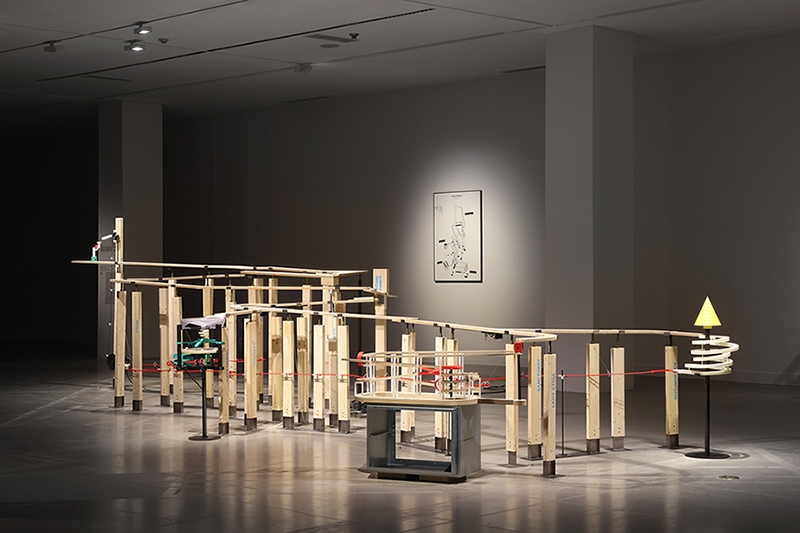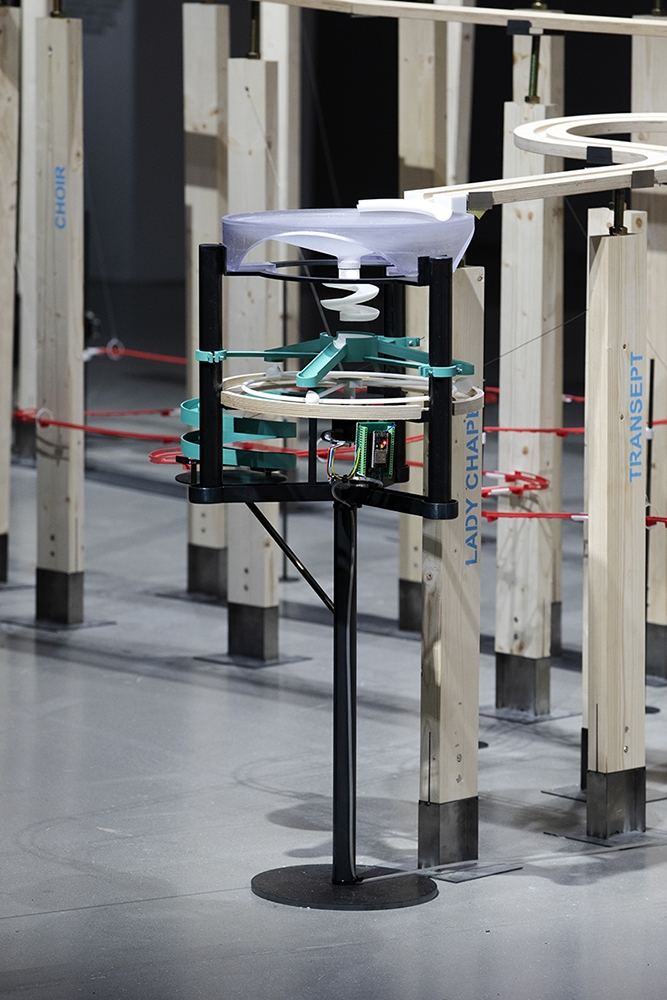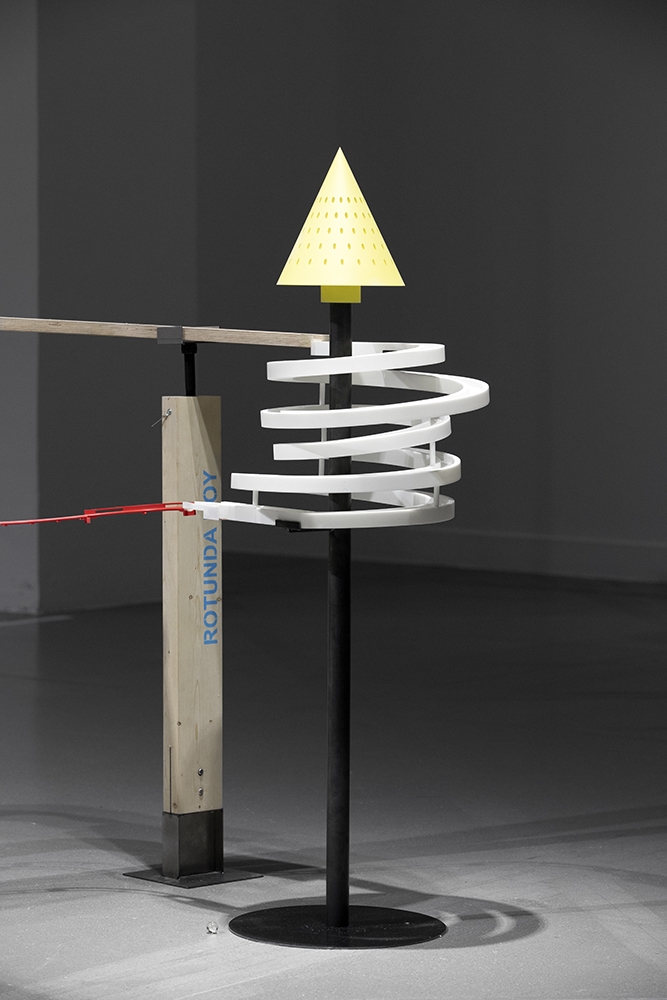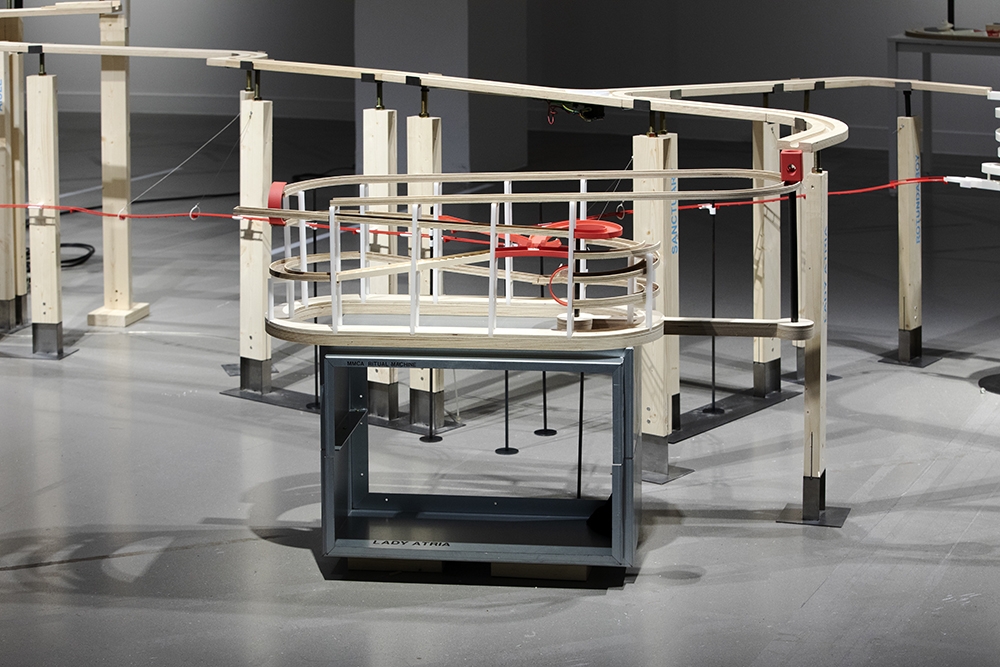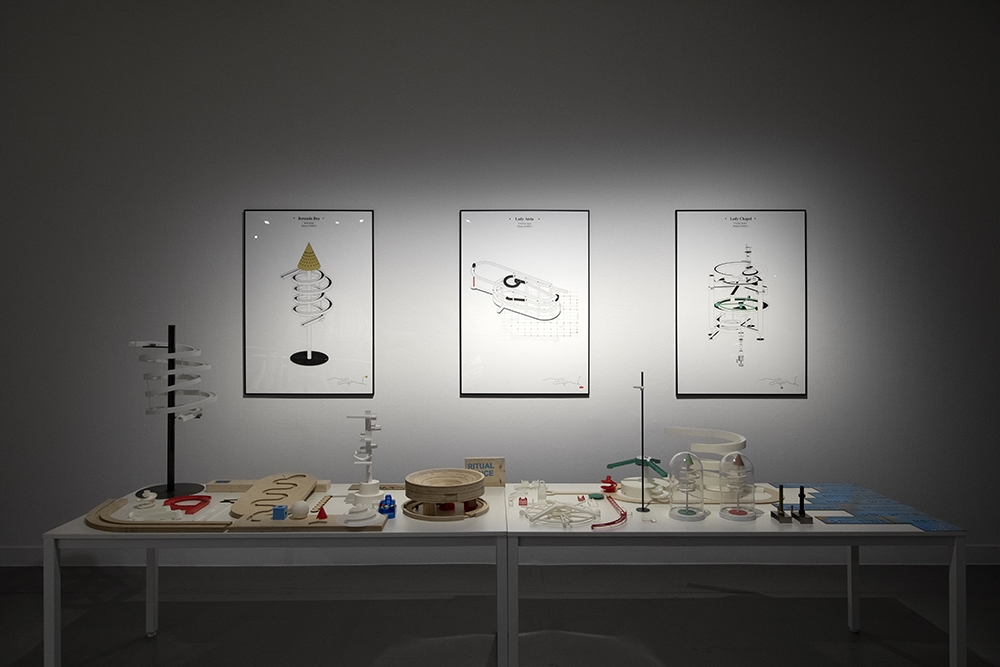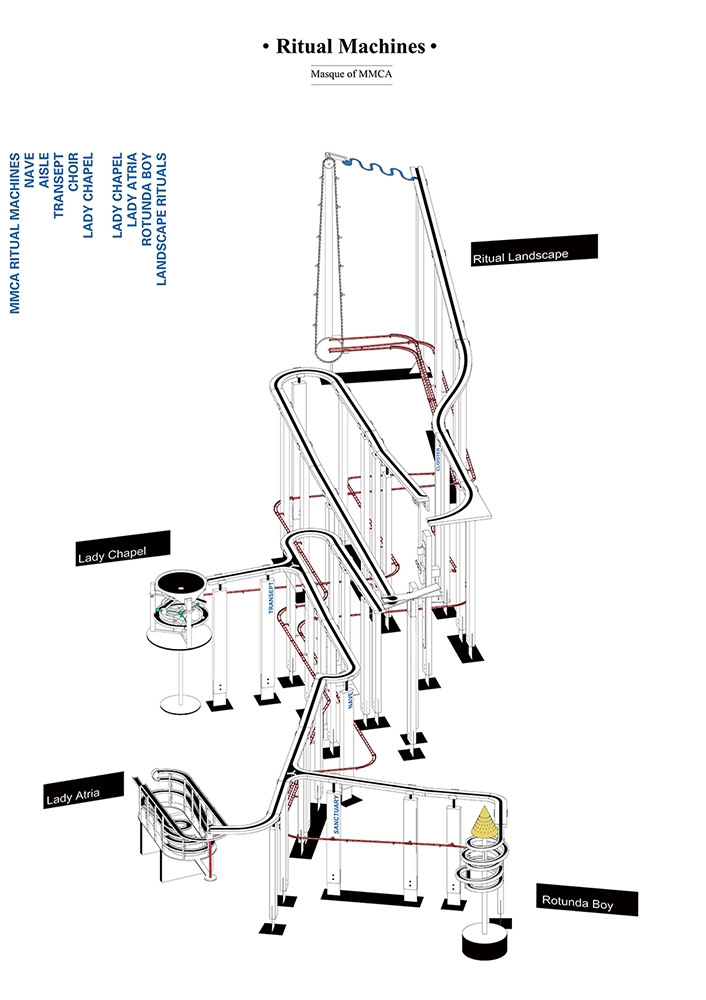MMCA
MMCA Ritual Machine, 리추얼머신, 2023
젊은모색 2023: 미술관을 위한 주석 Young Korean Artist 2023: Annotating the Museum
청계산 안쪽 깊숙한 곳에 자리잡은 국립현대미술관 과천관. 청계산의 풍경을 바라보면서, 산자락을 굽이 굽이 돌아 느리게 미술관 정면을 향해 걸어간다. 돌다리를 지나 미술관 로비에 도착해 표를 확인한 후, 어둑한 입구 넘어 로툰다로 들어선다. 중앙의 <다다익선>에서 오른쪽으로 돌아 나선램프을 통해 아트리움 전시공간으로 진입해 작품들을 만난다. 로툰다의 나선램프가 연결하는 전시공간들을 산책하다 보면 어느새 발걸음은 원형의 옥상정원으로 향한다. 대공원역에서 미술관으로 향하는 동안 만났던 청계산의 풍경이 다시 파노라마로 눈 앞에 펼쳐진다. - 2022년 겨울의 미술관 리추얼
일상에서 벗어나 미술관을 방문해 예술 작품을 감상하는 것은, 중세 순례자들이 대성당 공간의 흐름에 따라 성직자가 집전하는 성찬례에 참여하면서 찬양, 기도와 묵상을 이어나가는 것과 유사하다. 즉 전통적인 미술관 공간과 종교공간은 의례(ritual)라는 관점에서 비교할 수 있다. 사제들이 계획한 전례 절차에 따라 신도들을 성찬례에 참여시켜 종교적인 경험으로 인도하는 것처럼, 미술관에서 작품을 감상하는 관람객들은 공간의 의도된 질서와 동선, 큐레이터의 계획된 방향에 따라 예술 작품들을 경험하게 된다. 더불어 관람객들은 공간의 강약과 리듬, 질감, 패턴을 읽어내며 예술작품과 조우한다. 과천관은 미술관 경험이라는 관점에서 특별히 더 의례와 연결된다. 산을 돌아 진입하는 미술관 접근 방식, 로툰다 공간에 의한 수직/수평 동선의 연결과 다양한 외부공간 체험은 방문객이 각자의 방식으로 의례적인 경험(Ritual experience)을 완성해 가는 것을 의미한다.
리추얼 머신 (Ritual Machine)
<리추얼 머신>(Ritual Machine)은 과천관이 미술관으로서 갖고 있는 의례(Ritual)적 특성들을 탐험하는 프로젝트다. 과천관 건축의 물리적인 볼륨과 공간의 리듬, 섬세하게 계획된 전시 시퀀스에 따라 예술작품을 경험하는 관람객과 이를 계획한 건축가, 이후 전시를 기획해 나가는 큐레이터의 관계들을 다시 들여다보고 이를 예찬하는 의미를 가진다.
<리추얼 머신>은 ‘로툰다’(Rotunda), ‘나선램프’(Spiral ramp), ‘아트리움’(Atrtium), ‘원형 정원’ 등 과천관의 주요 건축을 은유하는 기하학적 형태들을 가진다. 이들은 미술관 의례를 위한 배경과 무대이자 스스로 주인공이 된다. 관람객들은 리추얼 머신에 직접 참여하거나 램프를 여행하는 구슬(marble run)을 따라 시선을 이동하면서 미술관 의례를 경험한다.
건축적인 기계장치 (Architectural Machine )
기계장치(machine & devices)를 건축의 주요 원리로 다룬 비트루비우스(Vitruvius)의 『건축 10서』이래로 많은 건축가들이 기계장치들을 고안하고 디자인해 왔다. 건축의 스케일, 예산, 재료의 한계를 넘어 자기 아이디어를 실험하기 위한 수단으로 기계장치가 이용되어 왔다. 건축적인 기계장치들은 궁극적으로 건축 공간으로 확장되고 그 일부로 발전할 수 있는 가능성을 보여준다. 이와 같은 맥락에서 리추얼 머신은 스튜디오 히치의 전작들과 연결되고 있다. 2021년 서울도시건축전시관 상부에 설치했던 <서울어반핀볼머신>(Seoul Urban Pinball Machine)은 기존 경사면을 활용한 거대한 핀볼머신을 시민을 위한 공공 공간으로 해석한 설치 작업이였다. 도시적인 놀이터이자 공공 퍼포먼스에 대한 실험이였다. 또한 2013년 영국 런던에서 진행한 설치작업 <건축 시간 장치>(Architectural Time Machine) 프로젝트는 고안한 기계장치가 특정 장소에 반응해 퍼포먼스를 펼치는 배우가 된다는 측면에서 리추얼 머신과 이어진다.
Museum of Modern and Contemporary Art, Gwacheon is located deep in Cheonggyesan Mountain. Admiring the scenery of Cheonggyesan Mountain, I slowly walk around the foot of the mountain, toward the façade of the museum. Having passed the stone bridge and arriving at the lobby of the museum, I hand the ticket and enter the rotunda beyond the dim entrance. I take the circular ramp in clockwise direction around Nam June Paik’s The More, The Better in the center, and enter the exhibition space in the atrium where I come to face art works. Walking through exhibition spaces connected by the spiral lamp in the rotunda, I notice that my feet are headed to the circular rooftop garden. The scenery of Cheonggyesan Mountain, which I engaged with on my way to the museum from Grand Park Station, unfolds in front of my eyes in panorama.
Heechan Park, Art Museum Ritual in the Winter of 2022
Deviating from the world of daily life and visiting the museum to view art works is similar to how medieval pilgrims followed the sequence of spaces in grand cathedrals, praising, praying, meditating and partaking in the sacrament held by priests. In other words, the space of the traditional art museum and religious space can be compared from the perspective of the “ritual.” Just as the priests burn incense and lead the congregation to participate in the sacrament according to the precedent procedure of the ritual and lead the congregation to a religious experience, visitors viewing art works in the art museum come to experience the art works according to the intended order and route in the space, in the planned direction of the curator. Going on further, the visitors encounter the works, reading the dynamics, rhythm, texture, and pattern of space. MMCA Gwacheon is especially connected to ritual in terms of museum experience. The approach to the museum by going around the mountain, the connection of vertical and horizontal movement created in the rotunda space, and the diverse experiences of external space signifies the perfection of the “ritual experience” of the visitors in their own way.
Ritual Machine
Ritual Machine is a project which explores the “ritualistic” characteristics evident in MMCA Gwacheon as an art museum. The project is meaningful in that it celebrates the material volume and rhythm of space in MMCA Gwacheon, and its relationship between the museum, the audience who experiences the art works according to the planned exhibition sequence, the architect who organized it such way, and the curator who put the exhibition together.
Ritual Machine take geometric forms that metaphorically reference the rotunda, spiral ramp, atrium, and the circular garden. They are the backdrop of the museum ritual, as well as its theatrical stage, and becomes the protagonists themselves. The audience experiences the “museum ritual” by directly partaking in the ritual machine, or by moving their gaze along the marble run that travels the ramp.
Architectural Machine
Ever since Vitruvius laid out the fundamentals of architecture in terms of machinery and devices in The Ten Books on Architecture, countless architects have designed machines and devices. Machines and devices have often allowed architects to push the boundaries of scale, budget, and materials, enabling the designers to experiment with and test their architectural ideas. Architectural machines and devices ultimately lead to the actual architectural space they come to occupy, and reveal their potential to evolve into a part of the architecture. It is in such context that the Ritual Machine finds continuity with the previous works of Studio Hitch. The Seoul Urban Pinball Machine installed in the upper levels of Seoul Hall of Urbanism & Architecture in 2021 is one such work. The installation utilizes existing slopes of the building to create a public space for the visitors, as an experiment on public performance while also providing an urban playground. Meanwhile, the Architectural Time Machine Project installed in London in 2013 shares a connection with Ritual Machine in that the machinery responds to the specific place to become the performing protagonists.
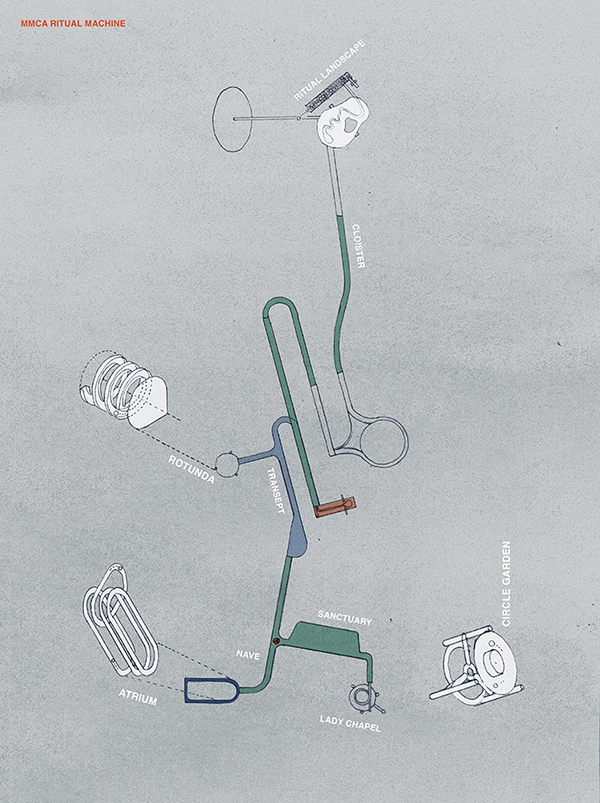 Drawing by Heechan Park
Drawing by Heechan Park
